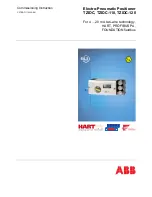
Sense Port
Center Port
(Pilot Inlet
Supply)
Vent Port
Flowgrid Slam Shut | 11
9. VENT VALVES AND GAUGE CONNECTIONS:
Vent
valves and gage connections are recommended in the
inlet and outlet piping to the slam shut and downstream
regulator. These are a great convenience during start up,
maintenance, and operation.
10. TOKEN RELIEF VALVES:
Installation of a token relief
valve in the line downstream of the slam shut is recom-
mended. The relief valve should be set to open before
the slam shut valve is set to close. Minor over pressure
problems such as gas thermal expansion or seat leakage
due to dirt moving through the system will be handled by
the relief valve, while maintaining a supply of gas to your
customers. Major malfunctions of the regulator beyond
the flow capacity of the token relief will activate the slam
shut valve.
Setup
When the flapper valve is in the open position the flapper
and the flapper lever can suddenly close. Hands and
fingers caught in between the flapper and flapper seal or
in the way of the flapper lever when the valve closes may
result in bruises, cuts and/or broken bones.
Regulator Setup:
The slam shut sense line may be shut off with a valve while
the downstream regulators are setup and put into operation.
Shutting off the slam shut sense line will prevent the slam shut
from repeatedly closing during regulator setup.
Failure to open the sense line shut off valve will prevent
the SSV from when the closing set point is reached.
Setting the Slam Shut Closing Set-Points
1. Prior to starting check label located on the spring case for
single function controllers or labels on the spring cases for
dual functions controllers. Verify that the controller has the
correct functions, over pressure and/or under pressure
for the application. Also verify that the desired set-points
are within the spring ranges marked on the Over Pressure
Spring Range and/or Under Pressure Spring Range
labels. If the functions or spring ranges are incorrect, the
label, spring and or valve may need to be changed out.
See the maintenance section for instructions in making
the changes
2. On dual function controllers equipped with over pressure
and under pressure protection, the over pressure set
point should be made first with the under pressure
protection screw completely backed out.
Setting the Over Pressure Set-Point
1. Remove the cover on top of the over pressure spring
case which can be identified by the gold Over Pressure
Protection Spring Range label. Tighten the set point
adjusting screw located on top of the spring case.
2. If the slam shut valve is closed, it will need to be opened.
To open the valve, first equalize the pressure across the
flapper valve and bleed off the sense pressure. Then
using a 1/2 inch SAE or 13 MM wrench turn the flapper
lever counter clockwise into the latched position. Hold
the flapper lever in the latched position until the actuator
pressure bleeds off and the pawl lever latches the flapper
lever.
3. Adjust the sense pressure to the required over pressure
set-point.
NOTE: If the slam shut valve closes at a lower pressure
then the required over pressure set-point then the set
point is too low. Increase the set point by tightening
the adjusting screw on top of the spring case and then
return to step 2.
4. Adjust the over pressure set-point by loosening the
adjusting screw until the slam shut closes. When the
slam shut closes, the controller is set at the approximate
set point.
5. Open the slam shut valve by equalizing the pressure
across the flapper valve and bleeding off the sense
pressure. Then using a 1/2 inch SAE or 13 MM wrench
turn the flapper lever counter clockwise into the latched
position. Hold the flapper lever in the latched position
until the actuator pressure bleeds off and the pawl lever
latches the flapper lever.
6. Increase the sense pressure until the slam shut valve
closes noting the pressure it closes at. Adjust the
set-point if required and tighten the jam nut.
7. Repeat steps 5 and 6 until the slam shut valve repeatedly
closes at the required pressure. Install the cover over the
adjusting screw.
Figure 8 - Sense Ports.
DANGER
WARNING


























